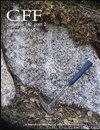俄罗斯巴伦支海三叠系—侏罗系碎屑岩物源调查研究
IF 1.2
4区 地球科学
Q2 GEOLOGY
引用次数: 6
摘要
摘要对俄罗斯(东)巴伦支海南部Franz Josef Land及井中三叠系和侏罗系的21个样品进行了U-Pb联合锆石测年,并对39个样品进行了全岩化学组成和Sm-Nd同位素研究。利用Kolmogorov-Smirnov (K-S)检验对碎屑锆石年龄分布的相似性进行了统计分析,指出了三叠纪至中侏罗世碎屑物质的共同源区。所有样品以乌拉里亚时代的碎屑锆石为主,加里东时代和罗马尼亚时代的碎屑锆石相对较少。古元古代和太古宙的颗粒数量很少,只有在少数侏罗纪样品中才有意义。下三叠统的εNd(t)值从- 1.5 ~ +2.5逐渐减小,侏罗纪的εNd(t)值从- 2.0 ~ - 8.2逐渐减小,表明古变质基底侵蚀对新侏罗系岩石的影响越来越大。下三叠统岩石中Co/Th比值高,表明基性岩受到侵蚀,而Th/Sc比值高,表明长英质岩受到侵蚀,仅在部分上三叠统和侏罗系岩石中出现。我们认为乌拉尔盆地和三叠纪西西伯利亚盆地的基底是研究碎屑岩的主要物源。相比之下,东欧克拉通的基底侵蚀产生的细粒碎屑碎屑较少,这一时期的特征是起伏较缓。本文章由计算机程序翻译,如有差异,请以英文原文为准。
A reconnaissance provenance study of Triassic–Jurassic clastic rocks of the Russian Barents Sea
ABSTRACT Combined U–Pb detrital zircon dating of 21 samples, along with whole-rock chemical composition and Sm–Nd isotopic studies of 39 samples of Triassic and Jurassic rocks from Franz Josef Land and wells in the southern part of the Russian (eastern) Barents Sea, were analyzed for a reconnaissance provenance study. The similarity of detrital zircon age distributions was statistically assessed using the Kolmogorov–Smirnov (K–S) test and points to a common source area for the clastic material of Triassic to Middle Jurassic age. Uralian-age detrital zircons predominate in all samples, with a comparably smaller portion of Caledonian- and Timanian-age detrital zircons. The number of Palaeoproterozoic and Archean grains is very small and becomes significant only in a few Jurassic samples. εNd(t) values gradually decrease from −1.5 to +2.5 in Lower Triassic rocks, to −2.0 to −8.2 in Jurassic rocks, suggesting an increasing influence of ancient metamorphic basement erosion in the younger Jurassic rocks. High Co/Th ratios, suggesting the erosion of mafic rocks, were mainly recorded in Lower Triassic rocks, whereas increasing Th/Sc ratios, suggesting the erosion of felsic rocks, were recorded only in some uppermost Triassic and Jurassic rocks. We identify the Urals and, in addition during the Triassic, the basement of the West Siberian Basin as the main provenance for the studied clastic rocks. By contrast, only a small volume of fine-grained clastic detritus was derived from basement erosion of the East European Craton, which was characterized by a subdued relief during this time.
求助全文
通过发布文献求助,成功后即可免费获取论文全文。
去求助
来源期刊

Gff
地学-地质学
CiteScore
2.80
自引率
10.00%
发文量
11
审稿时长
>12 weeks
期刊介绍:
GFF is the journal of the Geological Society of Sweden. It is an international scientific journal that publishes papers in English covering the whole field of geology and palaeontology, i.e. petrology, mineralogy, stratigraphy, systematic palaeontology, palaeogeography, historical geology and Quaternary geology. Systematic descriptions of fossils, minerals and rocks are an important part of GFF''s publishing record. Papers on regional or local geology should deal with Balto-Scandian or Northern European geology, or with geologically related areas. Papers on geophysics, geochemistry, biogeochemistry, climatology and hydrology should have a geological context. Descriptions of new methods (analytical, instrumental or numerical), should be relevant to the broad scope of the journal. Review articles are welcome, and may be solicited occasionally. Thematic issues are also possible.
 求助内容:
求助内容: 应助结果提醒方式:
应助结果提醒方式:


